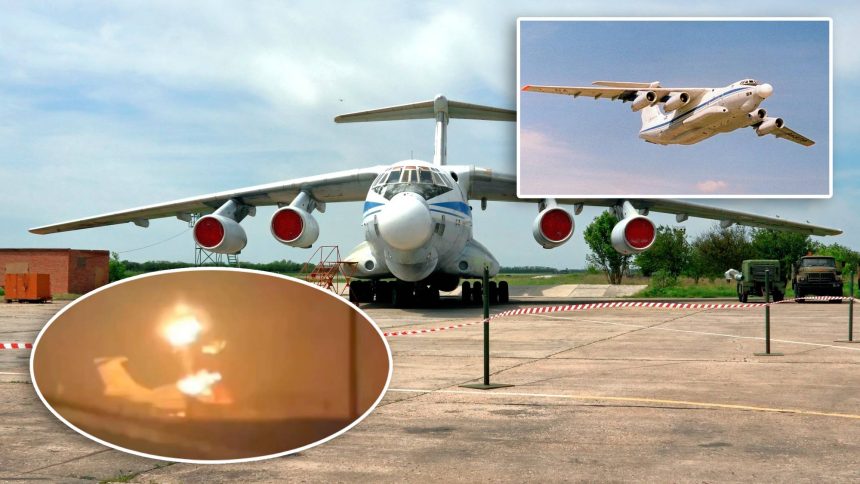Two ultra-rare Russian aircraft have been destroyed in an attack on aircraft manufacturer Beriev’s plant near the Black Sea city of Taganrog.
Alongside damage to Beriev’s facility itself, which is a repair facility for Russia’s Beriev A-50 ‘Mainstay’ airborne early warning (AEW) aircraft fleet, satellite imagery depicts the destruction of two Ilyushin Il-76 type aircraft. Upon closer inspection, cross-referencing with historical imagery from both the ground and air, these aircraft were specifically a Beriev A-60 and, reportedly, an A-100LL. Official Ukrainian sources state that the strike involved cruise missiles and one-way attack drones.
The Beriev A-60 concept was roughly analogous to the U.S. Air Force’s Boeing NKC-135 Airborne Laser Lab and Boeing YAL-1, providing an airborne platform for the testing of directed energy laser weapons for use in the missile defence role. The first A-60 flew in 1981, though was later destroyed. A second aircraft was converted for the programme and entered service in 1991, though it would shortly be grounded in the aftermath of the Soviet Union’s collapse. Little activity was then seen until 2009, when photos showed that the A-60 had apparently returned to flight.
Things then went mostly quiet again, though the global interest in new laser weaponry as well as Russia’s need for game-changing technologies in its war against Ukraine has sparked recent interest in a potential revival of the programme. Whether or not this revival was to be forthcoming now is irrelevant, as Ukraine has taken a step ahead and neutralized any Russian hopes of returning the jet to the skies with a massive plume of fire and smoke.
In addition to the A-60 flying laboratory, a regular Ilysuhin Il-76 transport plane was also destroyed as a result of Ukrainian strikes on the Taganrog Yuzhny Air Base last night.
The final assembly workshop operated by the Beriev Aircraft Company suffered damage.… https://t.co/N6TjFRKqnm pic.twitter.com/s2zr9unVPB
— Status-6 (Military & Conflict News) (@Archer83Able) November 25, 2025
Meanwhile, the other aircraft shown to be destroyed in the Ukrainian attack is thought to be a one-of-a-kind testbed aircraft designated the A-100LL, the prototype for Russia’s new A-100 AEW jet. The A-100LL had the mounting points on the upper fuselage for the AEW radome, but the radome itself was not fitted. Though the jet has been mothballed for some time – with testing of the A-100 now transferred to the first, and currently only, production airframe – its destruction still represents a heavy blow, making the potential use of the aircraft for any trials, or even conversion to operational capability, completely out of the question.
Beriev A-100LL s/n RF-93953, 52 red, was a airborne laboratory for ground and flight testing of equipment for A-100 programme. The last known flight took place in 2018. pic.twitter.com/SnfXEpJI9J
— The Military Watch (@MarcinRogowsk14) November 25, 2025
Russia’s ageing A-50 AEW fleet is already small, but it has been reduced even further by losses suffered during the war with Ukraine. Parked A-50s have been targeted by FPV drones while at least two have been shot down. Without the A-50s, Russia can rely only on ground-based radars – with much shorter effective ranges – for air defence and attack direction. Even when A-50s are available to provide AEW cover, the successful shootdowns mean that they likely now keep a greater distance away from the frontlines than would be ideal in order to safeguard the aircraft. Only a handful of A-50s are still operational, and its A-100 replacement seems to be making little progress.
Damage to the Beriev plant, where A-50s are serviced and the A-100 is, theoretically, produced, will almost certainly place even further restrictions on Russia’s AEW operations. We do not know if there were any aircraft inside the facility at the time of the strike, though it seems likely that there were, and it is possible these have also suffered damage. Sending jets to be serviced at the facility, even after it is repaired, will surely be an option to be avoided as much as necessary since it would then place those aircraft in an established line of fire.
Though not a Beriev product, their facility at Taganrog additionally oversees maintenance of and upgrades for Russia’s Tu-95 ‘Bear’ strategic bombers and their Tu-142 maritime patrol counterparts. As one of Russia’s primary platforms for launching large-scale cruise missile attacks against Ukrainian targets, any site related to the Bear fleet is likely to be high up on Ukraine’s priority list. The bomber fleet has already taken significant blows from Ukrainian drone strikes deep inside Russian territory, which garnered international attention and almost certainly were a source of major embarrassment for Russia.
Five sites inside Russia were targeted in Russia last night by Ukraine, per drone forces commander Brovdi and Ukraine’s General Staff.
Among them: Taganrog’s A-50 aircraft hub, a Molniya drone factory, Novorossiysk’s Sheskharis oil terminal, and the Tuapse refinery.
📹… pic.twitter.com/T9kUxuwrGQ
— Euromaidan Press (@EuromaidanPress) November 25, 2025
On the same night, Ukrainian strikes also targeted an Atlant Aero factory that produces the low-cost Molniya one-way attack drone, oil industry facilities in Novorossiysk and Tuapse, and at least one S-400 surface to air missile (SAM) system.









